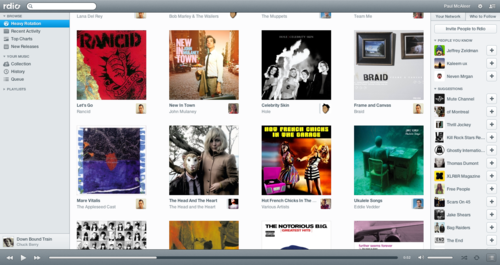I had the good fortune of attending the rdio relaunch event at SXSW this morning. I’ve had some time to play with the new interface now, and the general sentiment is positive.
I first saw the new UI by accident: one of the Macs at the venue had it wide open well before anyone took the stage, but as soon as someone pointed it out, it was disappeared. Super, super quickly. I mistakenly thought it was iTunes.
rdio looks a hell of a lot like iTunes now, or at least, iTunes under the previous OS X. It feels very quiet and, as rdio’s Wilson Miner said, the focus is on the content. This is a key differentiator for rdio now, as during the presentation they equated the traditional line-by-line view of an album (i.e., iTunes’s default view) with a spreadsheet. It’s pretty darn similar to the iTunes grid view.

I’ve always had an issue with Spotify’s dark interface. It turns me off and feels like it’s trying too damn hard. rdio has taken some of the key attributes from Spotify (mostly the contact list at right and source list at left) and brightened them up considerably. The album art is the star of the show here, as it should be. The color palette throughout the entire app is remarkably subdued. Other than the rarely-used rdio blue and social networks’ logos (Facebook, et al), the interface is solely shades of grey.
There are nice little touches too. The interaction when viewing who’s listening to an album is great and grid-happy:

6 icons is the width of the album art. Someone paid attention to that.
Miner also made it a point to show, essentially, that the back button works now and the app’s responsiveness is super fast. Both true. I enjoy the social panel thingie more than I thought I would. It updates in real time, so I can instantly see what anyone on my list is listening to. And being able to drag-and-drop albums or stuff to people is a killer feature in Spotify that I’m pleased to see here.
In the end, this feels like iTunes on the web in many ways. If Apple’s strategy centered around the web, they’d likely create a fully web-based iTunes. It’d be integrated with Ping, if people cared about it. And ultimately you’d end up with something like rdio. That’s not a bad place to be, but I worry if it’s enough.